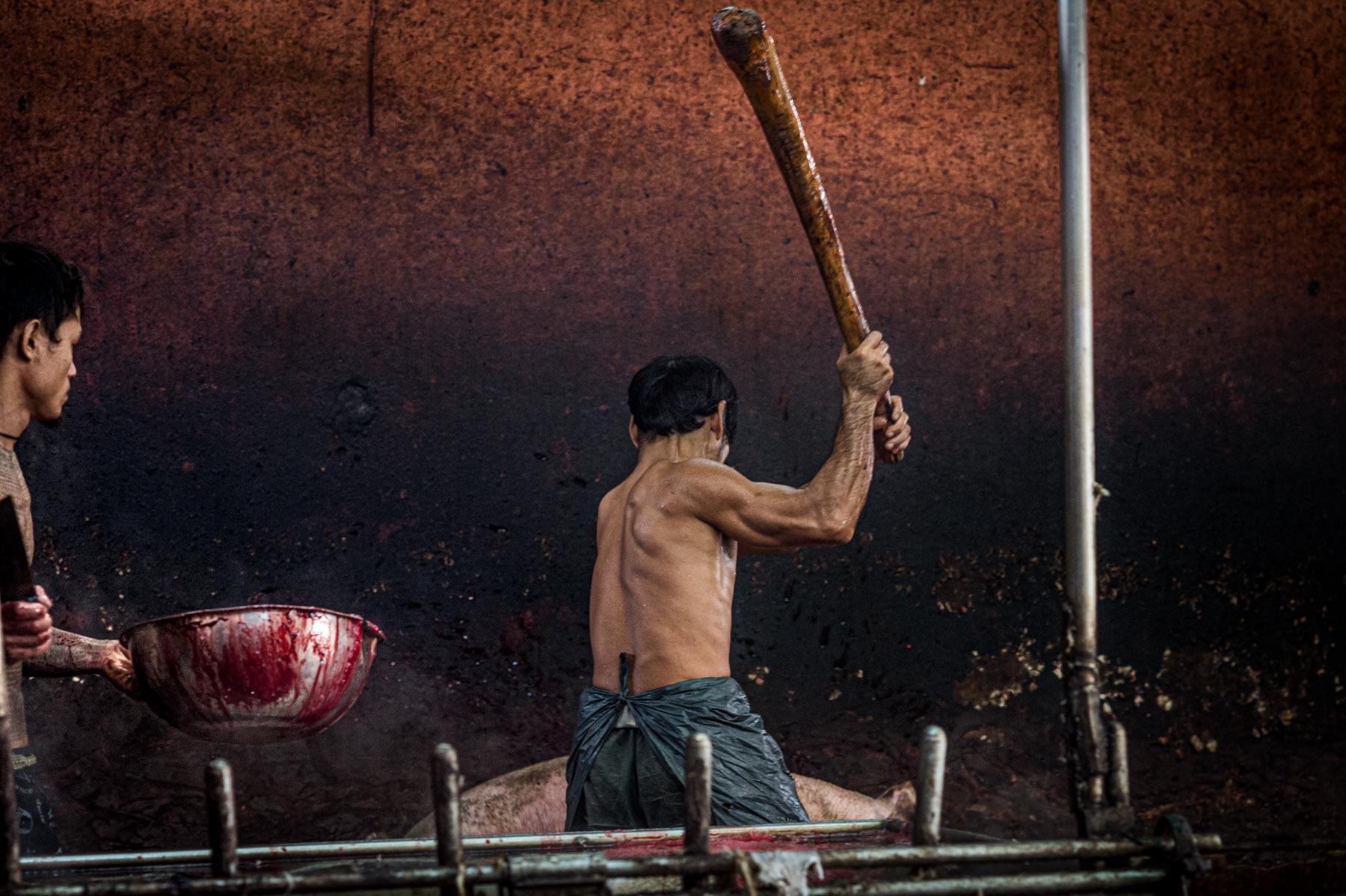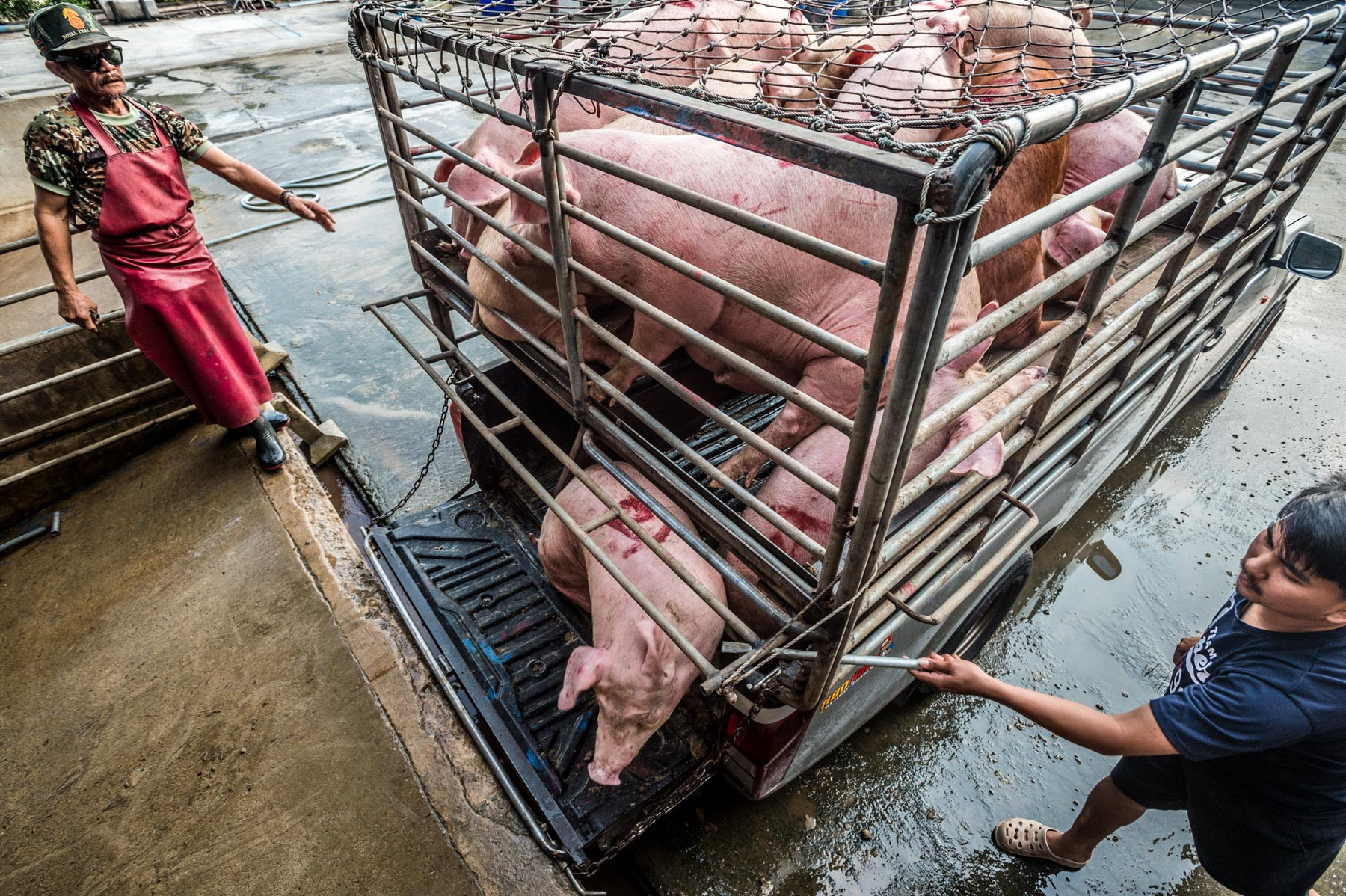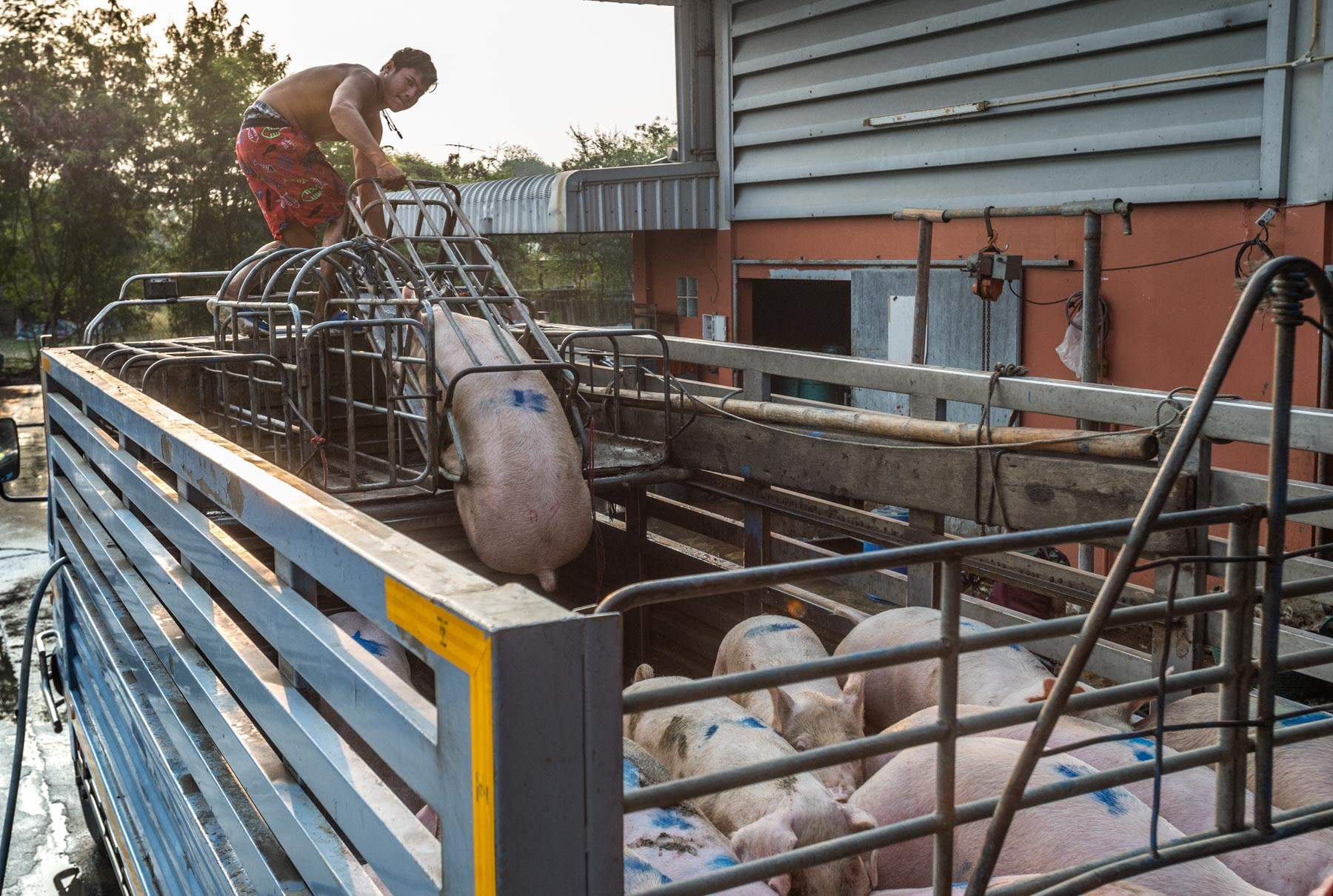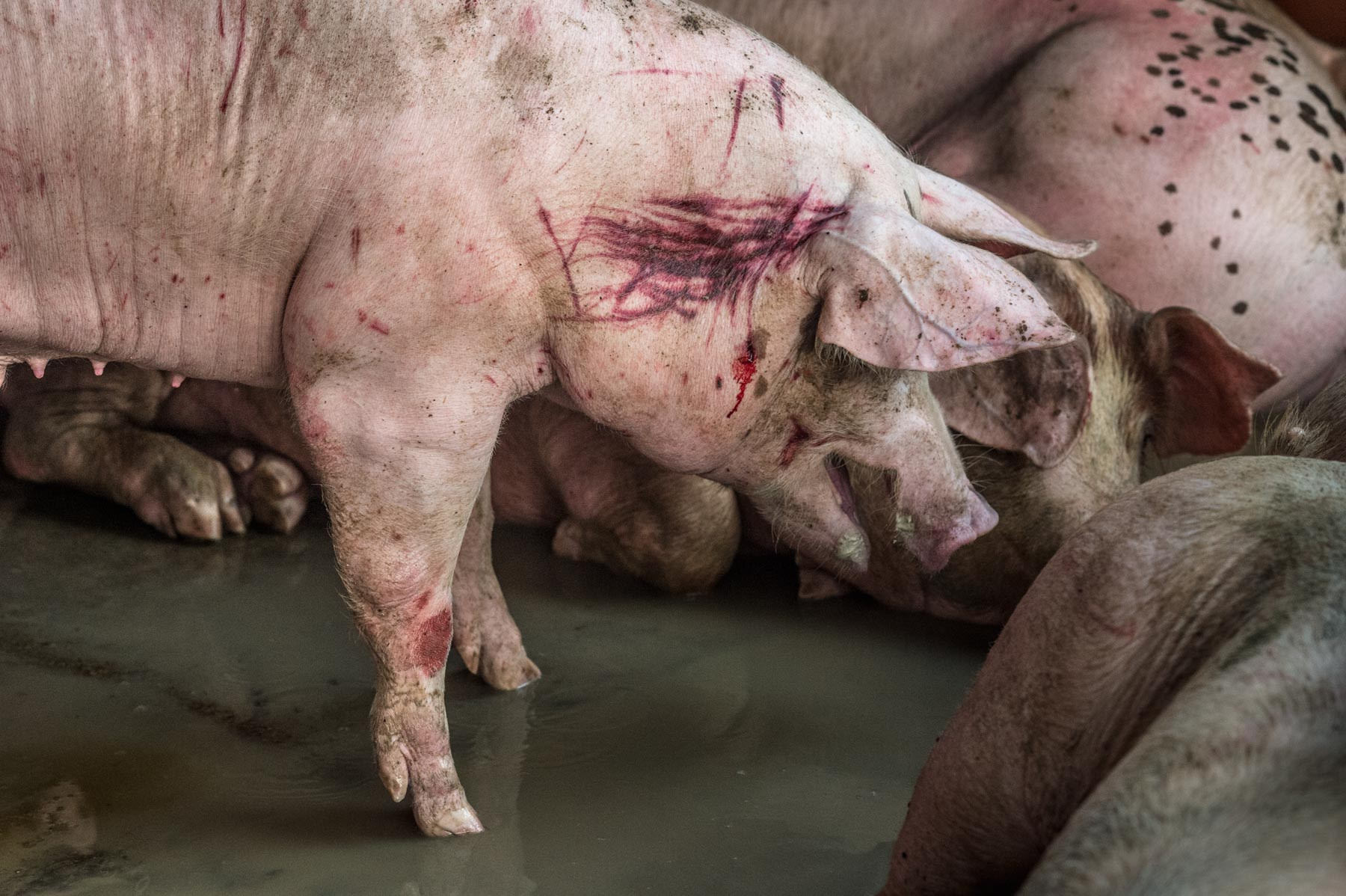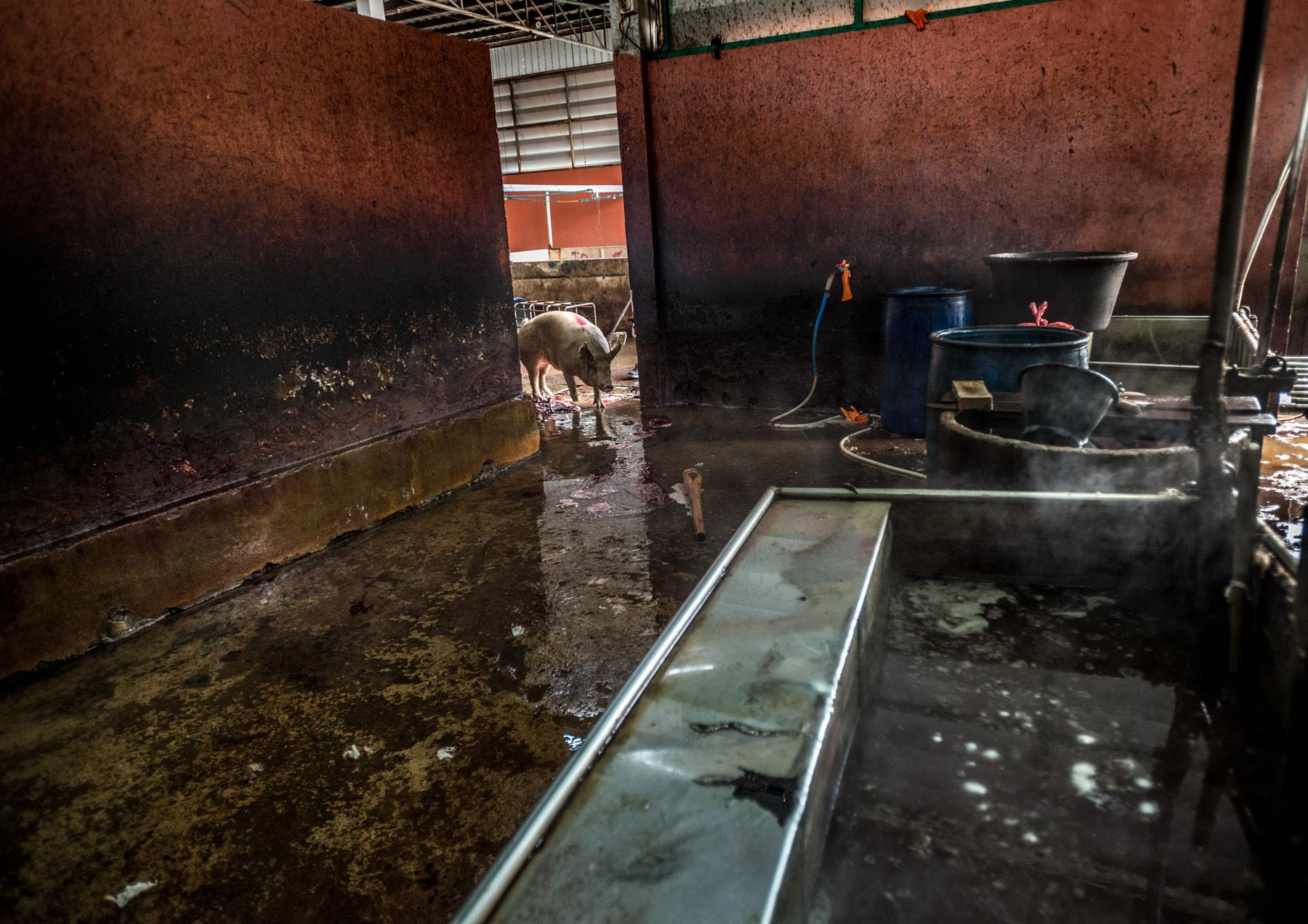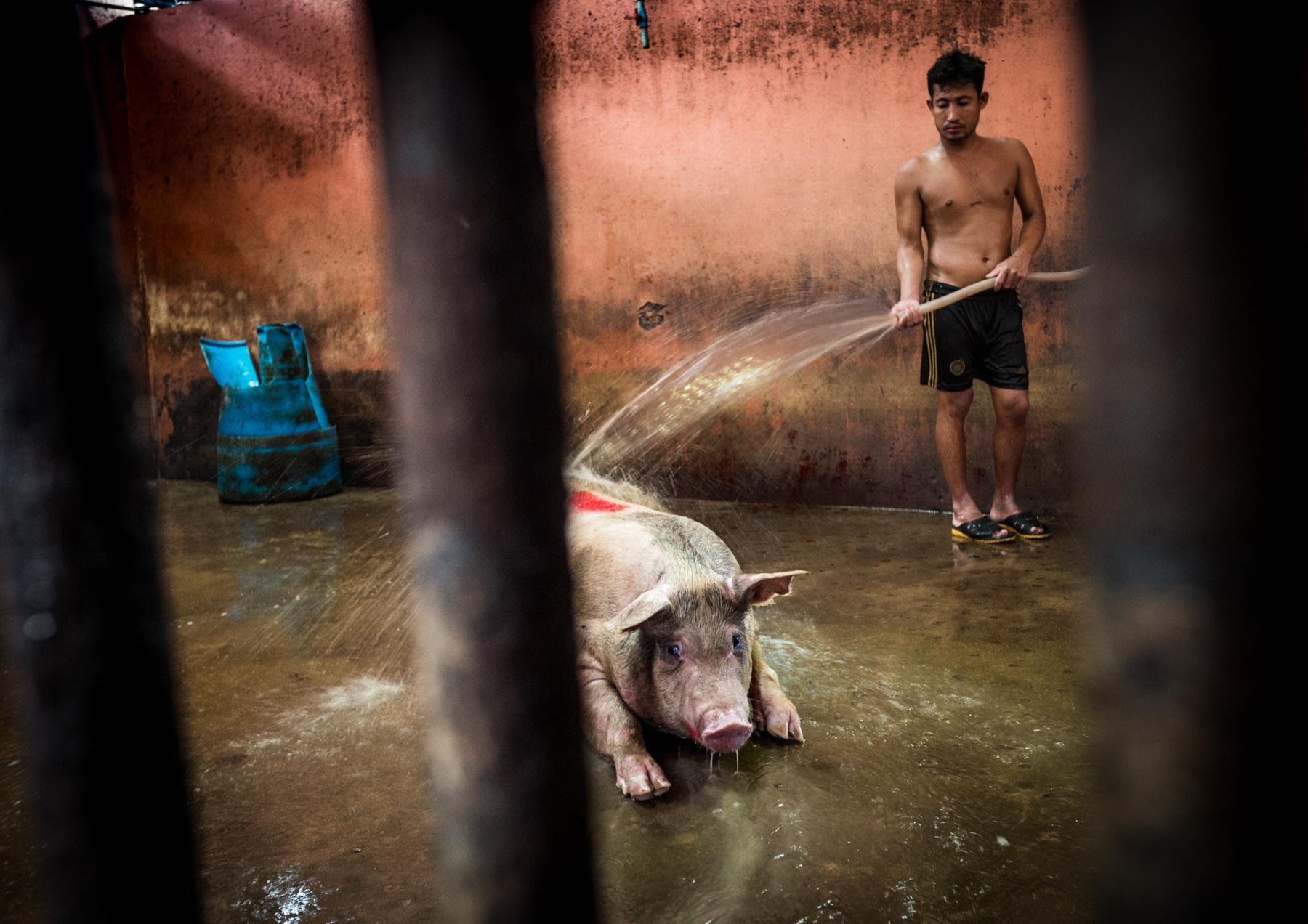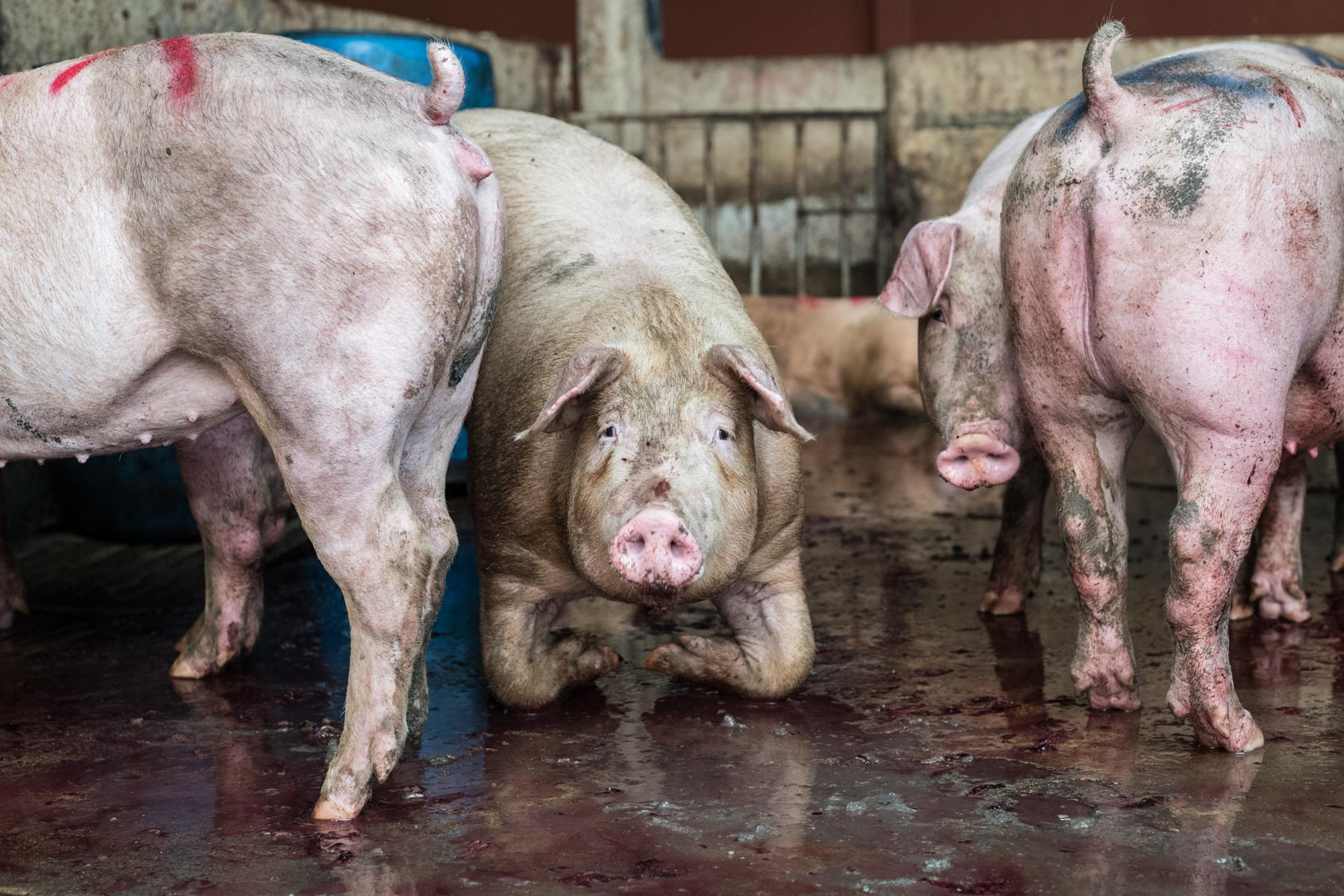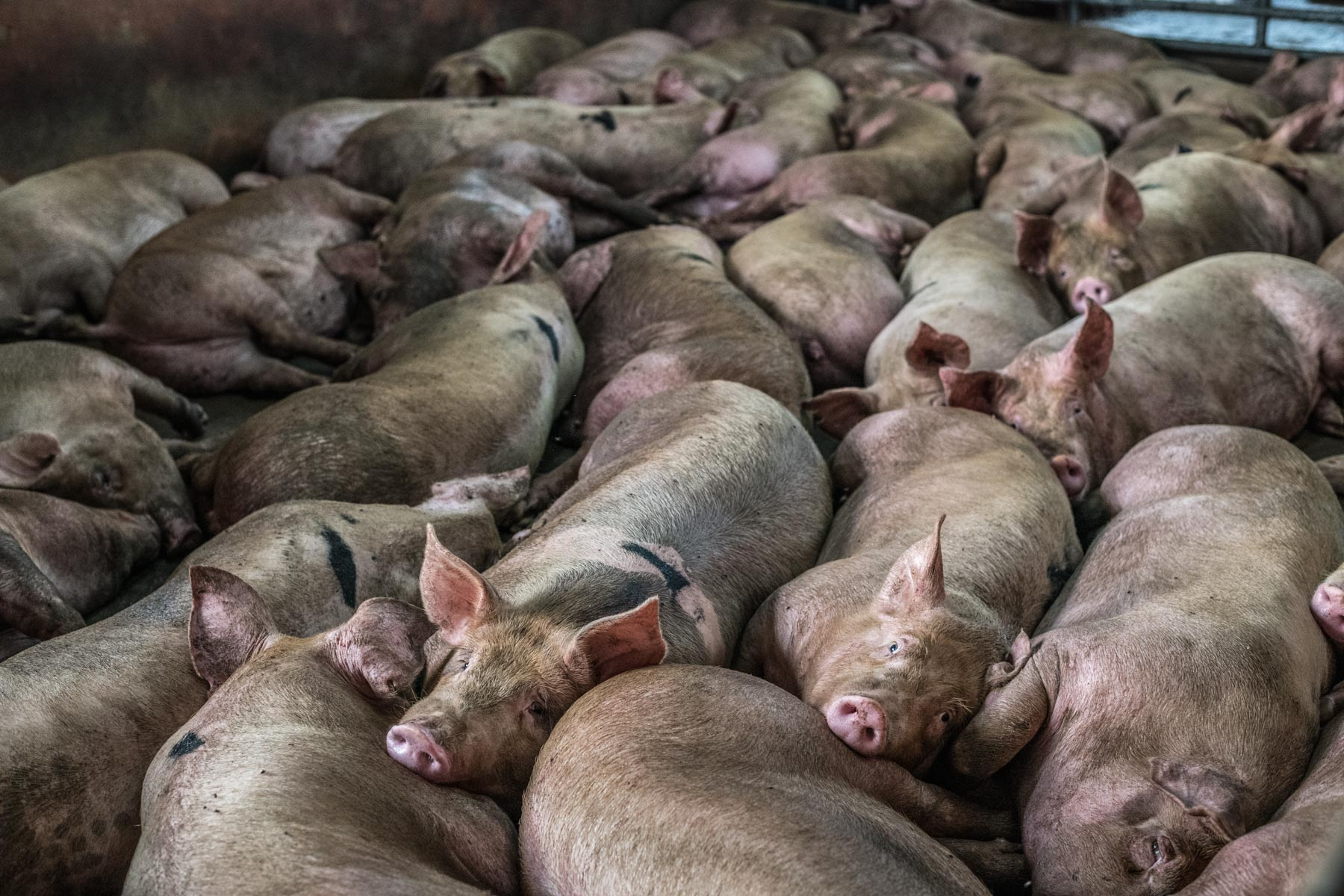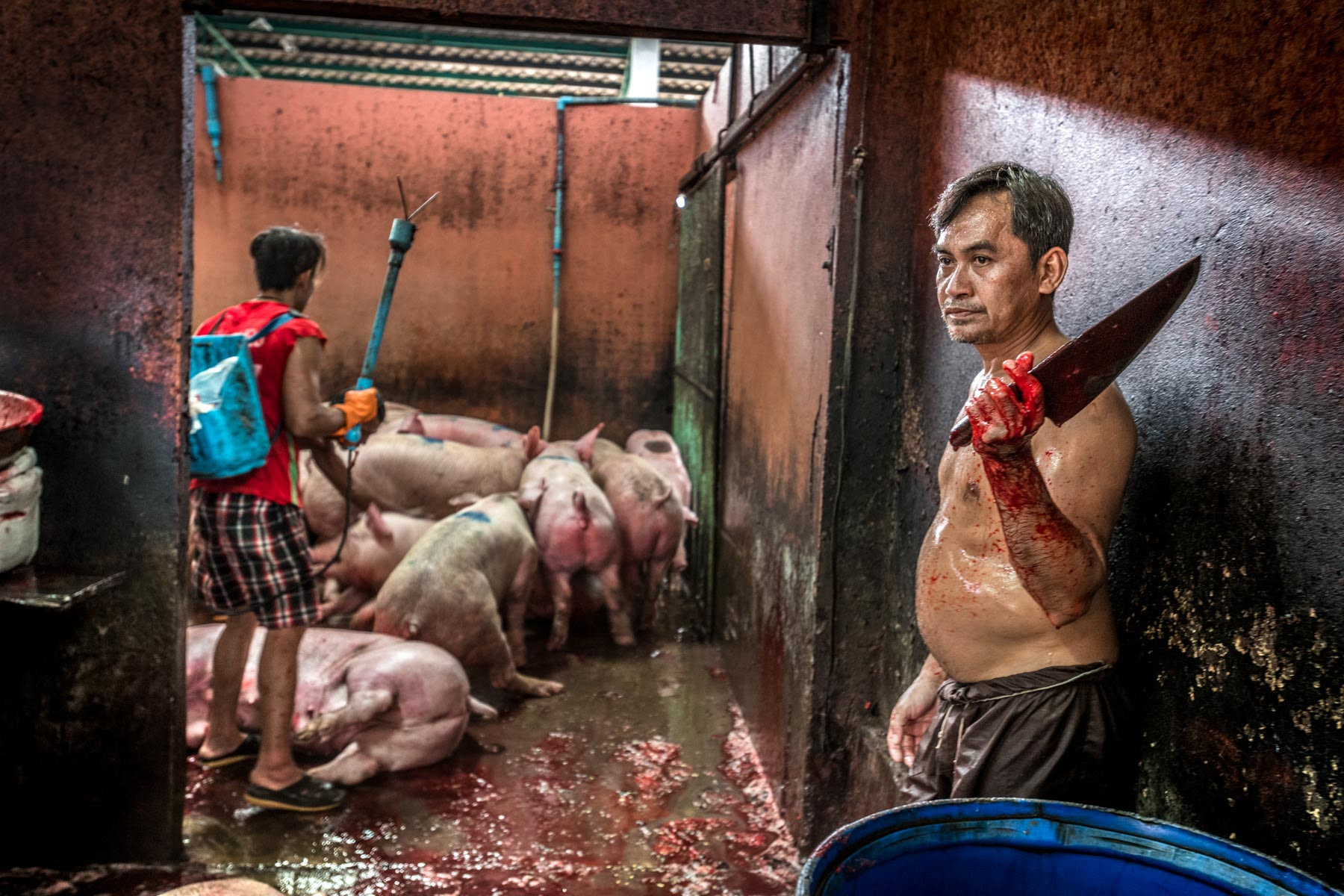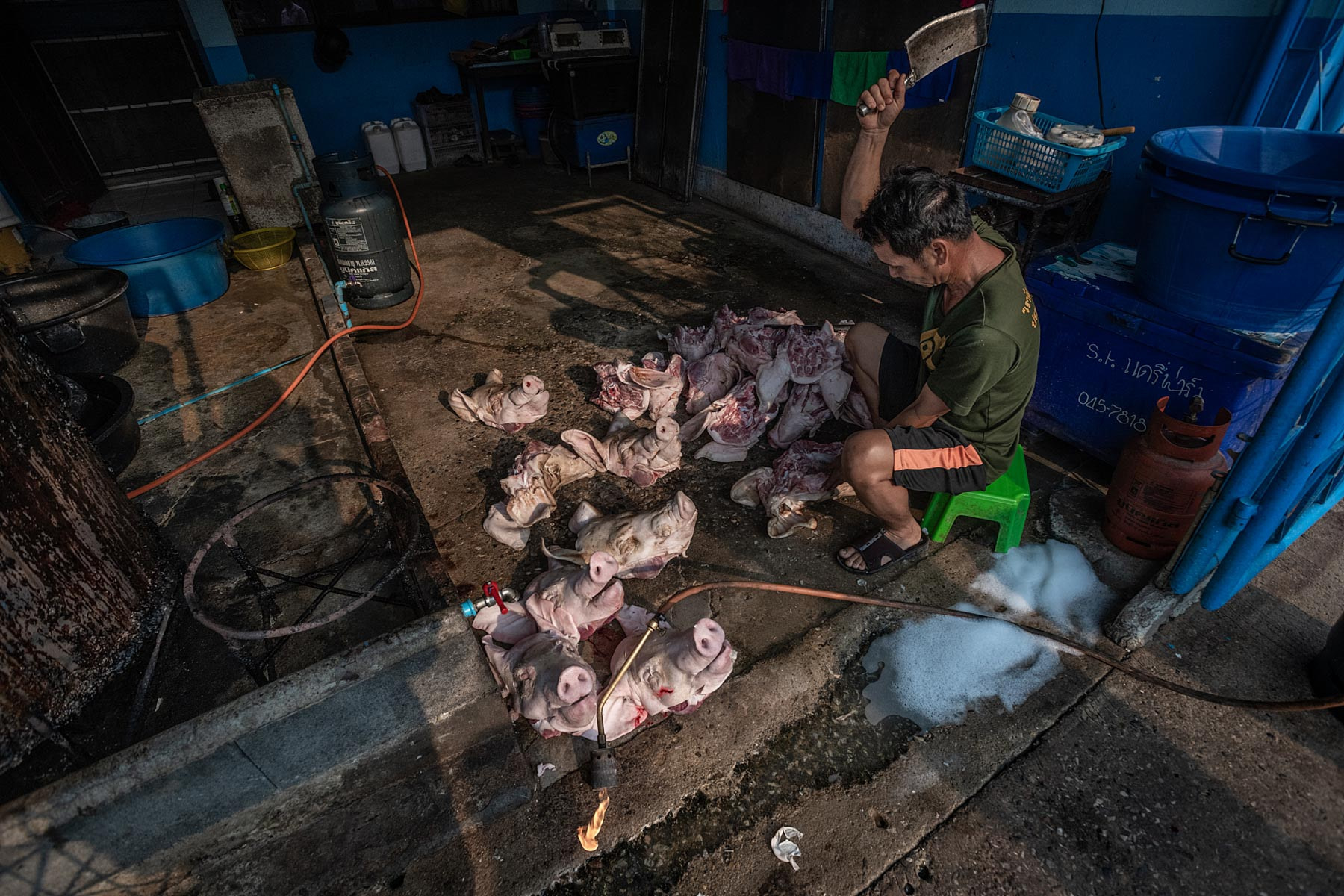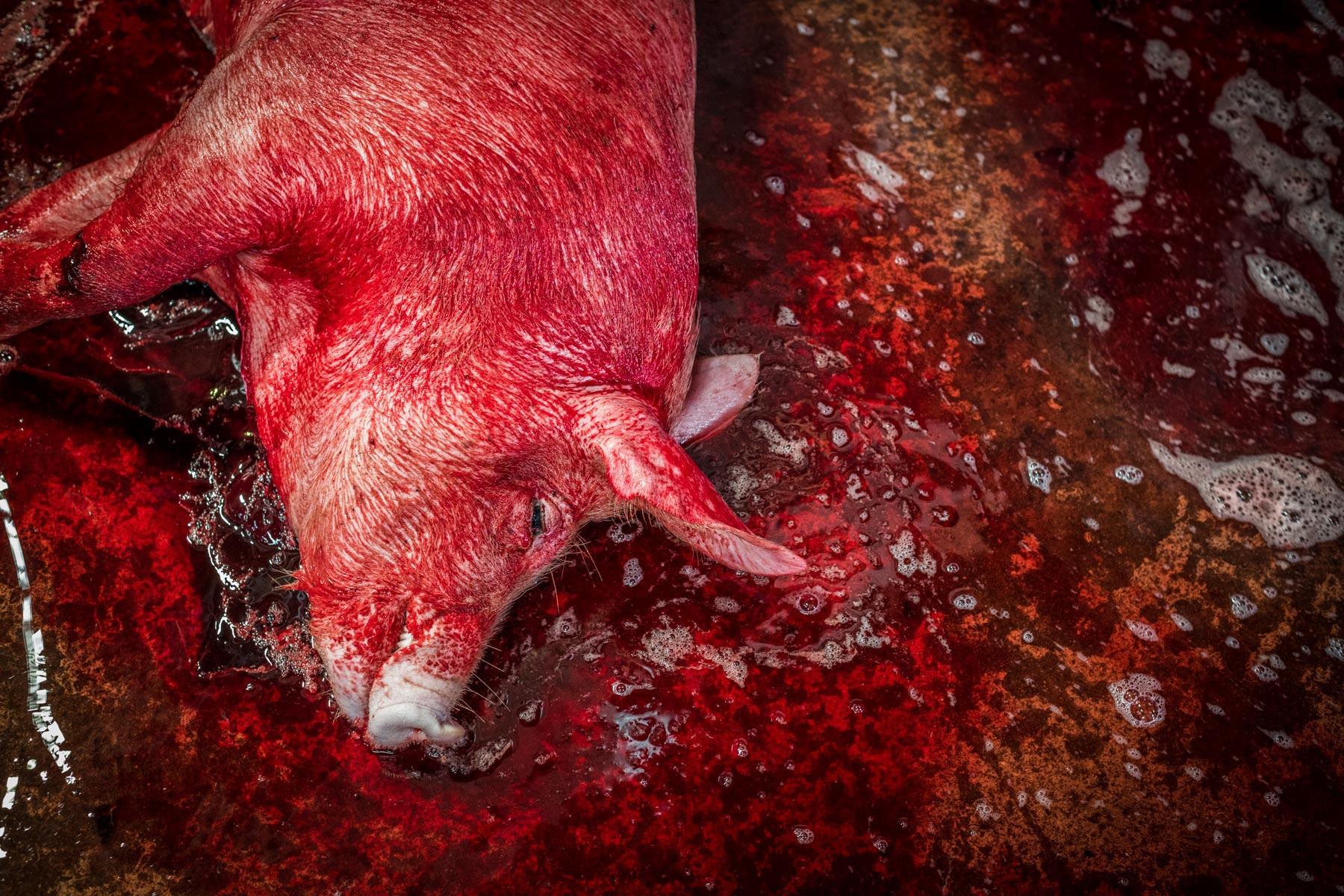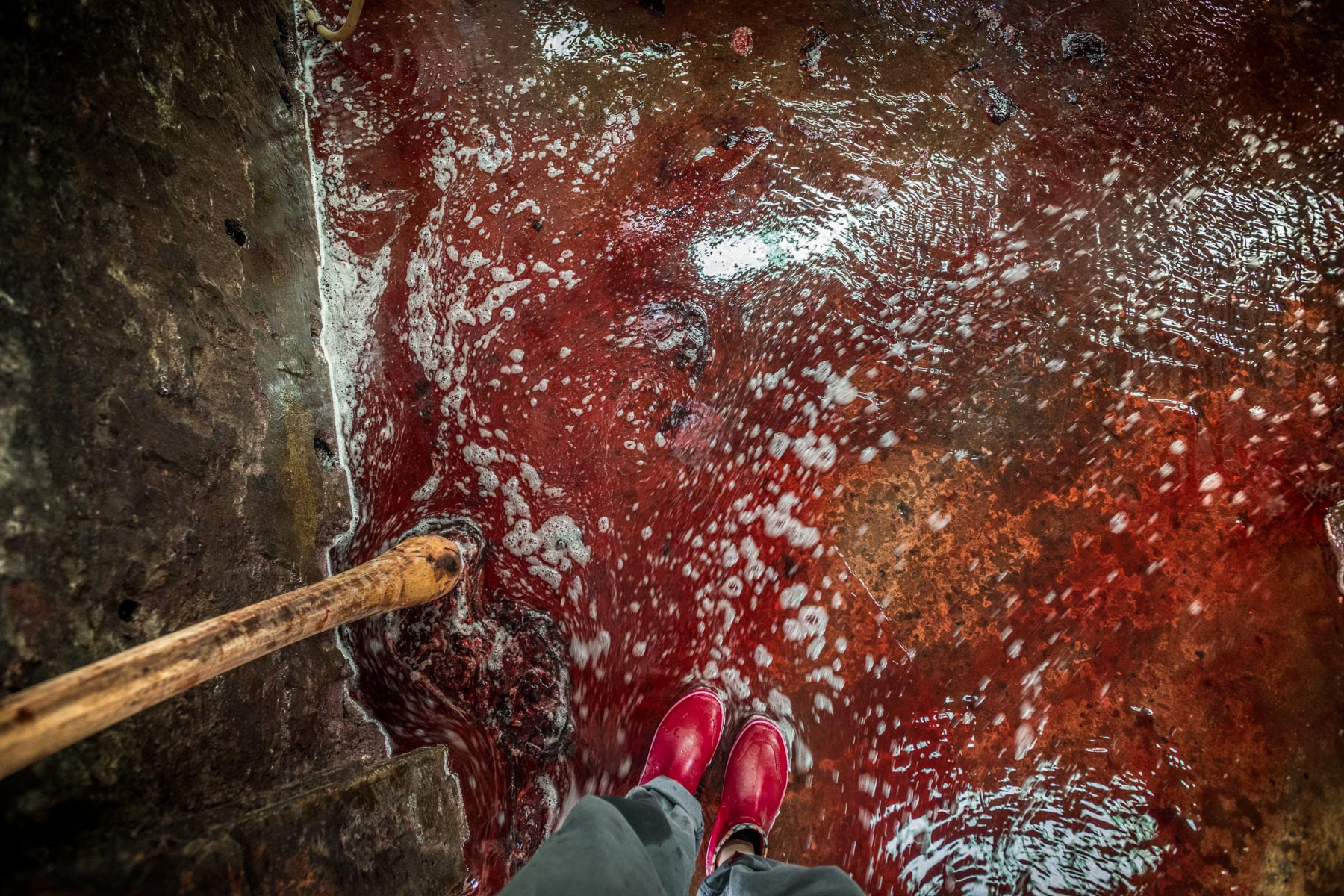A pig is clubbed before having their neck slit at slaughter. Bangkok, Thailand, 2019.
Jo-Anne McArthur / We Animals for The Guardian
[Content warning: Contains confronting images and/or video footage]
We are disconnected from what we eat and who we eat, and from the extent of suffering that billions of animals are subjected to. I went to Asia to help build vital connections between what is happening with the rise of industrial animal farming there and its many consequences.
Photographer: Jo-Anne McArthur
In early 2019, I spent a month documenting industrial farming and slaughter in Thailand and Taiwan for clients, NGO campaigns, and for our We Animals Asia series. This work was supported on the ground by Thai activists and the help of a fixer.
People often ask how I get access to tell these stories, seen or unseen. The simple answer is you get access if you show up, if you’re curious, and if you keep trying. However, it is very rare for a photojournalist to be warmly welcomed into a slaughterhouse and given all access, which is what happened to me a few hours’ drive from Bangkok.
I wasn’t the first to be welcomed here; the owner of the facility thinks it’s important for people to see the process of slaughter and once welcomed a group of veterinary students to spend a morning here too. He said that many of them vomited.
On this particular day, I was welcomed and escorted through the slaughterhouse doors with an invitation to spend the morning taking photos. I explored the circuit; the holding pens, the kill floor, and the area where the animals are gutted, dismembered and packed into trucks.
Unloading pigs from a two-level truck to a holding pen at a Thai slaughterhouse. Bangkok, Thailand, 2019.
Jo-Anne McArthur / We Animals for The Guardian
Through those early morning hours and into the afternoon, pigs arrived packed into small cages on pickup trucks that backed up to the holding pens for unloading. The pigs almost never moved forward at their own speed. Workers used electric prods and clenched long steel nails in their fists to stab them into motion.
From there, the pigs were ushered along the floor, through pools of soapy water and blood, and split up into several small holding pens. Some of the pens were already filled with sleeping pigs, who I believe had been delivered to the slaughterhouse the previous day. Snouts in the air, the new arrivals sniffed and shifted nervously as they took in their surroundings. As I’ve often seen at slaughterhouses and sale yards, pigs in confinement lash out at each other as they clamber for space and as a way to establish a hierarchy. It was the same here; fights started soon after they were packed inside the holding pens. A lot of pigs were bruised, scratched, and bloodied in the mix.
Prodding a pig onto the kill floor. Bangkok, Thailand, 2019.
Jo-Anne McArthur / We Animals for The Guardian
When the pigs were hosed down they huddled together, their backs turned to the slaughter room across the floor. Some screamed. Others seemed mute and immobile. Others shook. Many tried to escape when they were prodded or dragged soaking wet to the kill floor. Fear is recognizable across most species, and with the pigs here, it is undeniably palpable.
One by one, the pigs were knocked down, making the slaughter a bit easier for the men who would then stab a large knife under the pig’s jaw and slice downward to their sternum. The sound of pigs screaming, of water blasting from hoses and the heavy clang of metal and chains was overwhelming but I stayed quiet and photographed the workers, equally silent in their tasks.
A pig screams as she is clubbed before slaughter. Bangkok, Thailand, 2019.
Jo-Anne McArthur / We Animals for The Guardian
A stunning device is meant to render the animal senseless before slaughter, making the killing process more humane.
However, this machine was not only of the home-made variety but the training the worker received was very clearly and seriously misinformed; he was pressing it against the pigs’ snouts and eyes. Ineffective is one way to describe it. Once they felt I had taken enough photos they put the machine away and resumed clubbing the pigs to the ground.
Amid the chaos, pigs were left to bleed out for a minute or so in groups before another worker would jam a hook into their leg and then heave the animal into a vat of boiling water.
A pig being improperly stunned before being killed at a Thai slaughterhouse. The electrical current is being applied to the pig’s face and eyes. Bangkok, Thailand, 2019.
Jo-Anne McArthur / We Animals for The Guardian









The men would then set to scraping the pigs clean of hair, using sharp knives in a shaving motion, then deftly severing their heads and hooves. While men did the slaughtering and butchering, it was Burmese women in the back rooms who emptied and cleaned the pig intestines and organs.
I walked among the workers, the dead and dying pigs, their dismembered heads and body parts, trying to document everyone’s experience.
It is so highly unusual for me, a white, female westerner with expensive cameras, to be here mingling with Thai, Burmese, and Vietnamese slaughterhouse workers. Mostly, they laughed at me, but in a kind way. When I crouched down to photograph the dying, thrashing pigs, my face, my arms, all my clothes and my cameras, were splattered with their blood. The workers had long learned to work in shorts or even just underwear, sometimes with a plastic apron loosely wrapped around their waists.
Everyone asks how I can handle bearing witness to so much violence. It is brutal but I find catharsis in action. When I started out fifteen years ago, it would have been near impossible to get these images seen but when The Guardian published this story millions of people saw it. I truly believe we’re amid a global rise of engagement in animal journalism, a collective seeing.
Photographs lead people to change, and the momentum for hope of a different story for animals is what keeps me grounded.
For conflict photographers, our job is to do our best to capture the moments that tell the story of those who are at ground zero. Who is affected by the war or the violence? What does it look like on the front lines? It’s in these moments that photographs can galvanize, enrage, and inspire.
It’s here that still images move.
For about twenty-four hours after I left the slaughterhouse, my senses were painfully heightened. Colours and smells were exaggerated. Touch made me recoil. I wanted to crawl out of my skin and get away from a world so consummately replete with violence.







We are disconnected from what we eat and who we eat, and from the extent of suffering that billions of animals are subjected to. I went to Asia to help build vital connections between what is happening with the rise of industrial animal farming there and its many consequences.
Investigative work is but one part of the global rise in projects working to bring about justice and equality for non-human animals. On this day in Bangkok, as I stood in blood and soapy water sluicing around my rubber boots, I disengaged from myself in order to focus wholly on what was happening all around me. I focused on my breathing, steadied my hand, and clicked. And now you see.
I’m grateful to The Guardian, Dr. Wadchara Pumpradit, Nok Chida, and Kate Blaszak for the help and collaboration on this project.
Photographer: Jo-Anne McArthur
Explore and download visuals from this assignment via our stock platform and help tell these underreported stories.

